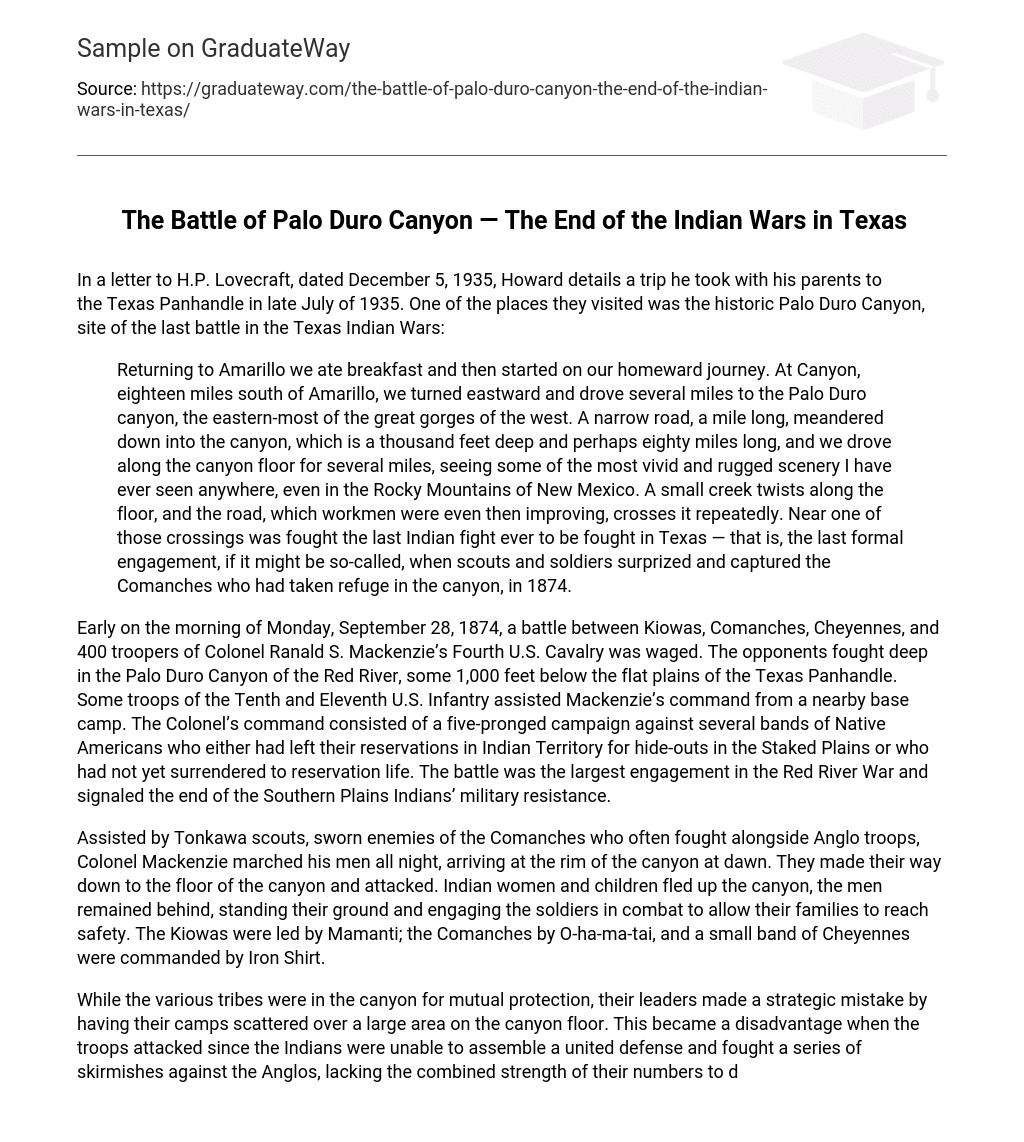In a letter to H.P. Lovecraft, dated December 5, 1935, Howard details a trip he took with his parents to the Texas Panhandle in late July of 1935. One of the places they visited was the historic Palo Duro Canyon, site of the last battle in the Texas Indian Wars:
Returning to Amarillo we ate breakfast and then started on our homeward journey. At Canyon, eighteen miles south of Amarillo, we turned eastward and drove several miles to the Palo Duro canyon, the eastern-most of the great gorges of the west. A narrow road, a mile long, meandered down into the canyon, which is a thousand feet deep and perhaps eighty miles long, and we drove along the canyon floor for several miles, seeing some of the most vivid and rugged scenery I have ever seen anywhere, even in the Rocky Mountains of New Mexico. A small creek twists along the floor, and the road, which workmen were even then improving, crosses it repeatedly. Near one of those crossings was fought the last Indian fight ever to be fought in Texas — that is, the last formal engagement, if it might be so-called, when scouts and soldiers surprized and captured the Comanches who had taken refuge in the canyon, in 1874.
Early on the morning of Monday, September 28, 1874, a battle between Kiowas, Comanches, Cheyennes, and 400 troopers of Colonel Ranald S. Mackenzie’s Fourth U.S. Cavalry was waged. The opponents fought deep in the Palo Duro Canyon of the Red River, some 1,000 feet below the flat plains of the Texas Panhandle. Some troops of the Tenth and Eleventh U.S. Infantry assisted Mackenzie’s command from a nearby base camp. The Colonel’s command consisted of a five-pronged campaign against several bands of Native Americans who either had left their reservations in Indian Territory for hide-outs in the Staked Plains or who had not yet surrendered to reservation life. The battle was the largest engagement in the Red River War and signaled the end of the Southern Plains Indians’ military resistance.
Assisted by Tonkawa scouts, sworn enemies of the Comanches who often fought alongside Anglo troops, Colonel Mackenzie marched his men all night, arriving at the rim of the canyon at dawn. They made their way down to the floor of the canyon and attacked. Indian women and children fled up the canyon, the men remained behind, standing their ground and engaging the soldiers in combat to allow their families to reach safety. The Kiowas were led by Mamanti; the Comanches by O-ha-ma-tai, and a small band of Cheyennes were commanded by Iron Shirt.
While the various tribes were in the canyon for mutual protection, their leaders made a strategic mistake by having their camps scattered over a large area on the canyon floor. This became a disadvantage when the troops attacked since the Indians were unable to assemble a united defense and fought a series of skirmishes against the Anglos, lacking the combined strength of their numbers to defeat them.
By mid-day the Indians had retreated, leaving behind their lodges and horses. Mackenzie ordered the lodges searched, and then put to the torch. The following day he instructed his men to slaughter 1,048 horses to prevent the Indians from recovering them. Rifle and pistol fire echoed through the canyon until the last horse fell. The sun-bleached bones of the massacred horses were visible for many years after the battle.
The Southern Plains Indians were fearsome opponents on horseback, but without horses or food, the proud “Lords of the Plains” were helpless and at the mercy of the Anglo troops. The Indians, resigned to their fate, trudged reluctantly into the reservations, having been left with no supplies for the coming winter. The only saving grace of the battle was the low casualty count — three Indians and one cavalry trooper died.
The battle of Palo Duro Canyon is important because it was the Southern Plains Indians’ desperate final, but futile effort at military resistance against the encroaching Anglo settlers who were moving further and further west into their territory.





